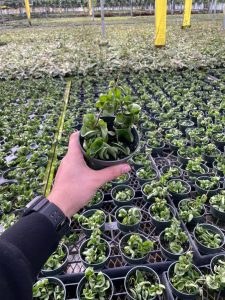Hoya Rope

- Botanical Name: Hoya carnosa 'Compacta'
- Family Name: Apocynaceae
- Stems: 1-1.5 Feet
- Temperature: 15°C~27°C
- Others: Climbing or trailing.
Overview
Product Description
Hoya Rope: The Twisted Traveler of the Tropics
Hoya Rope’s natural habitat is primarily distributed in parts of East Asia and Australia, where the regions typically boast tropical and subtropical humid climates, providing an ideal environment for Hoya Rope to thrive. As a member of the Apocynaceae family, it shares the same genus with plants such as Plumeria (frangipani), Periwinkle, Mandevilla, and Oleander, a family known for its diversity and extensive geographical distribution.

Hoya Rope
Hoya Rope: The Exotic Green Twist
Leaves
Hoya Rope, often admired for its distinctively coiled green foliage, boasts leaves that cascade along its vine-like stems, creating an appearance reminiscent of twisted ropes. This botanical oddity sets Hoya Rope apart in the realm of indoor flora, with its leaves being the star attraction. The spiraling, rope-like leaves are arranged in pairs, exuding a robust texture and a wrinkled surface that contrasts beautifully against their deep, verdant hue. These leaves not only add a touch of the exotic to any space but also serve as a testament to the plant’s resilience and unique evolutionary adaptations.
Flowers
The Hoya Rope is a floral marvel, capable of producing clusters of sweet-scented, star-shaped, and waxy blooms that typically range from delicate pink to pristine white, with a striking red center that adds a pop of color. These flowers not only bring a burst of natural fragrance to any environment but also serve as a beacon of life and vitality. With proper care, it rewards its cultivator with a succession of blooming periods throughout the warmer months, transforming indoor spaces into miniature gardens that burst with color and aroma.
Fruit
Much like its fellow Hoya species, it is also capable of producing seed pods after successful pollination, a phenomenon that, while infrequent in indoor settings, is a fascinating part of the plant’s reproductive cycle. These seed pods are not only a means of propagation but also a crucial element in the life cycle of the plant, showcasing the intricate balance of nature’s design. The potential to witness this rare event in an indoor environment adds an extra layer of intrigue to the care of Hoya Rope, making it a rewarding challenge for the dedicated plant enthusiast.
The Hoya Rope: Climbing to New Heights in Horticulture
Growth Habits:
Hoya Rope, a slow-growing, succulent, evergreen climber, is renowned for its trailing or climbing growth habit that adds a touch of tropical elegance to any setting. This plant’s versatile nature makes it an ideal candidate for hanging baskets, where its cascading foliage can create a lush, green curtain. Alternatively, when provided with the right support, it can climb and sprawl, transforming vertical spaces into living walls of greenery. Its ability to thrive in a variety of conditions makes it a popular choice for both indoor and outdoor environments, offering a unique botanical accent that brings the outdoors in.
Cold Hardiness:
Hoya Rope thrives in the warmth of indoor environments, making it a perfect addition to homes and offices where it can bask in the comfort of controlled temperatures. Its adaptability allows it to be grown outdoors in USDA Hardiness Zones 10-12, where it can enjoy the benefits of natural light and fresh air without the risk of frost damage. This makes Hoya compacta an excellent choice for temperate regions, providing a year-round greenery that can withstand mild winters and flourish in the warmth of spring and summer. Its hardiness and resilience make it a low-maintenance yet visually appealing option for those looking to add a touch of nature to their living spaces.
Hoya Rope is cherished for its distinctive, coiled vines and waxy leaves, which enhance aesthetics and purify indoor air. Its star-shaped blooms contribute natural hues and scents. Low-maintenance and adaptable, it brings vibrancy to any setting.










